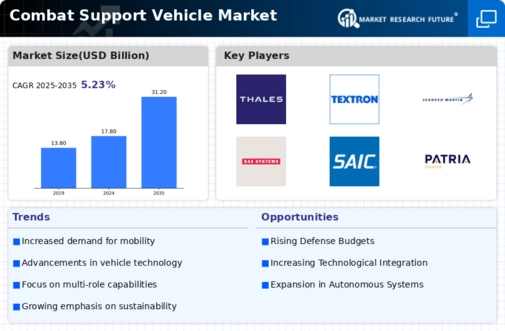Increased Defense Budgets
The Combat Support Vehicle Market is experiencing a notable surge due to increased defense budgets across various nations. Governments are prioritizing military modernization, which includes the procurement of advanced combat support vehicles. For instance, recent reports indicate that defense spending in several countries has risen by approximately 5 to 10 percent annually. This trend is likely to continue as nations seek to enhance their operational capabilities and readiness. The emphasis on advanced technology and improved logistics support is driving demand for combat support vehicles, which are essential for effective military operations. As a result, manufacturers are focusing on developing vehicles that meet the evolving needs of armed forces, thereby contributing to the growth of the Combat Support Vehicle Market.
Technological Advancements
Technological advancements are a driving force in the Combat Support Vehicle Market, as innovations in vehicle design and capabilities are reshaping military operations. The integration of advanced technologies such as artificial intelligence, autonomous systems, and enhanced communication networks is transforming the functionality of combat support vehicles. For instance, the introduction of unmanned ground vehicles is revolutionizing logistics and reconnaissance missions. Market data indicates that the adoption of these technologies is expected to grow, with projections suggesting a compound annual growth rate of around 6 percent in the coming years. This focus on technological integration is likely to enhance the operational efficiency of armed forces, thereby stimulating demand within the Combat Support Vehicle Market.
Rising Geopolitical Tensions
The Combat Support Vehicle Market is significantly influenced by rising geopolitical tensions around the world. As nations face increasing threats from regional conflicts and terrorism, there is a pressing need for enhanced military capabilities. This has led to a greater emphasis on the development and acquisition of combat support vehicles, which play a crucial role in logistics, reconnaissance, and troop support. For example, the ongoing conflicts in various regions have prompted countries to reassess their military strategies, resulting in increased investments in combat support vehicles. Analysts suggest that this trend may continue as nations strive to maintain a strategic advantage, thereby propelling the Combat Support Vehicle Market forward.
Increased Focus on Mobility and Versatility
The Combat Support Vehicle Market is witnessing a growing emphasis on mobility and versatility in vehicle design. Modern military operations require vehicles that can adapt to various terrains and mission profiles, leading to a demand for multi-role combat support vehicles. This trend is evident as armed forces seek to enhance their operational flexibility and responsiveness. Manufacturers are responding by developing vehicles that can perform multiple functions, such as troop transport, medical evacuation, and logistical support. Market analysis suggests that this shift towards versatile vehicle designs is likely to drive growth in the Combat Support Vehicle Market, as military organizations prioritize adaptability in their procurement strategies.
Sustainability and Environmental Considerations
Sustainability is becoming an increasingly important factor in the Combat Support Vehicle Market. As environmental concerns rise, military organizations are exploring ways to reduce their carbon footprint and enhance the sustainability of their operations. This includes the development of combat support vehicles that utilize alternative fuels and energy-efficient technologies. Recent initiatives have shown that integrating sustainable practices can lead to cost savings and improved operational efficiency. For example, the adoption of hybrid and electric propulsion systems is gaining traction, with some military programs aiming for a significant reduction in greenhouse gas emissions. This focus on sustainability is likely to shape future procurement decisions, thereby influencing the trajectory of the Combat Support Vehicle Market.

















Leave a Comment